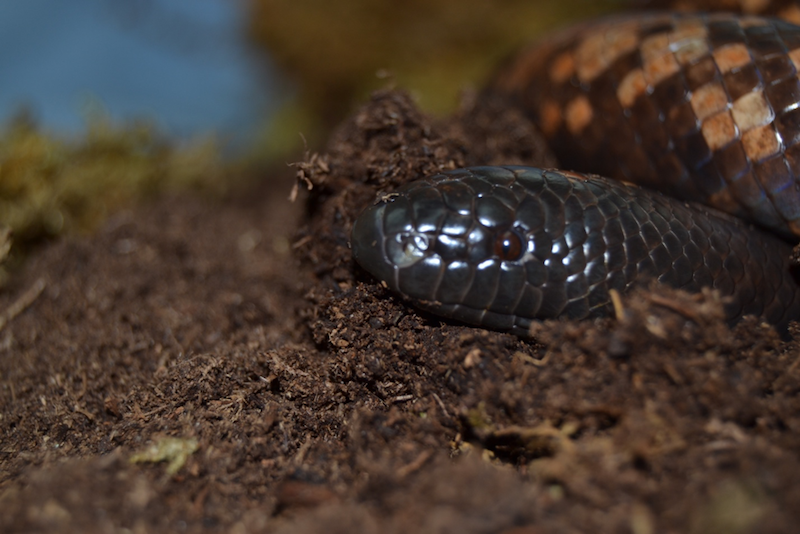 Evolution & Behaviour
Evolution & Behaviour
The snake with the skin of a rhino…that eats babies!
A rare African snake was recently found to have skin that is thicker and harder to pierce than “typical” snake skin. This tough skin may be a defense against the bites of parental rodents, since the snake feeds mainly on rodent babies.

Legends say that the rhinoceros has skin that can withstand a gunshot. Despite the slight exaggeration, without a doubt the rhinoceros bears one of the toughest hides in the animal kingdom, stretching as thick as 5 cm and woven together specifically to repel attacks. What if I told you a type of snake was found to have skin just as impressive as the rhinoceros? A snake wrapped in impenetrable skin...isn't that a horrific image?
Researchers compared the skin of 14 species of snakes, covering different evolutionary lineages and habitat preferences, and found that one species, Calabaria reinhardtii, stood out among the rest. First, its skin is way thicker than that of the average snake; roughly eight times thicker. That's like the difference between a leather jacket to a T-shirt! Second, the lower layer of skin, the dermis (in contrast to the upper layer, the epidermis), consists of dense, interwoven layers of collagen bundles, just like the dermis of the rhinoceros. In comparison, other snakes have loosely arranged collagen fibers. Collagen is a protein also found in bone and cartilage, and it contributes to the overall rigidity of the skin. The skin of Calabaria is also unusual in that there is not much of an interscale region. This is the space between scales in most snakes that provides flexibility, so a lack of it means that the skin is more resistant to pressure. All this evidence indicates that Calabaria has tougher-than-usual skin. Further biomechanics experiments proved this by showing that the skin of this snake is highly resistant to the piercing of both sharp and blunt syringe needles.
Fortunately, Calabaria reinhardtii is not the kind of snake that induces nightmares. It is actually a seemingly unremarkable creature, roughly one meter in length that spends most of its time underground in the rainforest floor. So why the thick skin? The first thought would be that it serves as a defense mechanism against predators, but unfortunately the lack of ecological data on this reclusive species makes this reasoning a hard one to prove. The tough hide of rhinos is designed to mainly reduce damage from horn blows from other rhinos during breeding season, which is certainly not the case for Calabaria.
One interesting fact we noted during the captive maintenance of this species is that it preys almost exclusively on baby rodents. It would ignore adults, even juvenile mice, it's only after the babies. By reading previous studies on this species, we confirmed that Calabaria reinhardtii has a very specialized form of prey capture. These snakes raid rodent nests (which are mainly subterranean) and preferentially ingest juvenile rodents, not the adults. Understandably, this predatory style leaves the snake vulnerable to retaliatory attacks from the parental rodents. Biting is the primary defensive behavior in rodents, and rodent bites can inflict significant tissue damage to snakes, even leading to death. Field studies of Calabaria reinhardtii have reported the snakes being attacked by adult, presumably parental, rodents. So the likely scenario is that this snake raids rat burrows, dining on the young while withstanding the assault from the angry parents with its extra-protective skin.
Why would it go through so much trouble, you say? The answer may be related to its jaw structure. As you may have seen in pictures and videos, most snakes are able to swallow prey much larger than their head. However, Calabaria reinhardtii's jaws are much stiffer. During evolution, one possible scenario is that the relatively inflexible jaws of the ancestors of Calabaria reinhardtii forced them to limit their prey to small items. This, coupled with living underground in a rainforest, potentially restricted that ancestral snake to preying on juvenile rodents. The ancestral snake was susceptible to fatal attacks from parental rodents, and individuals with extra-tough skin were better able to survive and thrive on their baby diet, evolving through time into the Calabaria reinhardtii we see today.
Calabaria reinhardtii is the first snake discovered to have skin specialized for defense, and the body armor's structural resemblance to that of the rhinoceros provides an excellent example of convergent evolution. The results of this study provide better understanding of a biological defense mechanism and offer inspiration for the development of synthetic armors.
Original Article:
D. Han, B. A. Young, The rhinoceros among Serpents: Comparative anatomy and experimental biophysics of Calabar burrowing python (Calabaria reinhardtii) skin. J Morphol 279, 86-96 (2018)Next read: Snake uses its split jaws as a knife and fork by Yosuke Kojima
Edited by:
Dr. Carlos Javier Rivera-Rivera , Managing Editor
We thought you might like
Are burrowing snakes digging their own evolutionary grave?
Oct 26, 2018 in Evolution & Behaviour | 3.5 min read by Vivek Philip CyriacMore from Evolution & Behaviour
Cicada emergence alters forest food webs
Jan 31, 2025 in Evolution & Behaviour | 3.5 min read by Martha Weiss , John LillSize does not matter: direct estimations of mutation rates in baleen whales
Jan 29, 2025 in Evolution & Behaviour | 4 min read by Marcos Suárez-MenéndezThe Claws and the Spear: New Evidence of Neanderthal-Cave Lion Interactions
Jan 22, 2025 in Evolution & Behaviour | 3.5 min read by Gabriele RussoA deep-sea spa: the key to the pearl octopus’ success
Jan 20, 2025 in Evolution & Behaviour | 3.5 min read by Jim BarryFeisty fish and birds with attitude: Why does evolution not lead to identical individuals?
Aug 31, 2024 in Evolution & Behaviour | 3 min read by Lukas Eigentler , Klaus Reinhold , David KikuchiEditor's picks
Trending now
Popular topics


